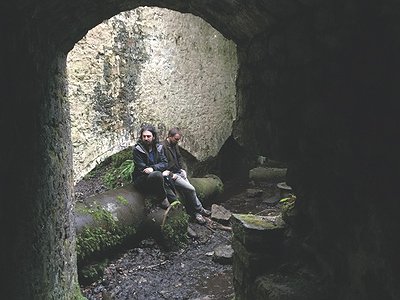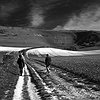Name: Mark O Pilkington and Michael J York as Teleplasmiste
Occupation: Publisher /Author / Musicians
Current Release: Frequency Is The New Esctasy on House Of Mythology
Musical Recommendations: MOP: I’m deeply impressed by Howlround at the moment, who we will be gigging with this year. Robin the Fog works solely with physical tape and loops to produce deeply alien environments – stretching the envelope of music concrete practices into other dimensions.
MJY: The Ocora Radio France album of Albanian Love songs and Complaints, its extremely subtle performances create some of the most magical, mesmerising and otherworldly music I’ve ever heard, all with just four human voices.
If you enjoyed this interview with Teleplasmiste, check out their Facebook page for more information.
When did you start writing/producing music - and what or who were your early passions and influences?
Mark O Pilkington: As a pre and early teen my great enthusiasm was for film and TV soundtracks, particularly SF and horror, which I would record through the TV speaker onto a portable cassette recorder to make compilations. I also loved the BBC Death & Horror Sound Effects cassette, which I remember buying in WH Smiths. Aged around eight I discovered Jeff Wayne’s War of the Worlds, which I played to bits, eventually recording my own narrative parts over Richard Burton’s – sadly the tape is now lost, though I still love War of the Worlds. I still prefer instrumental, “narrative” music to songs, with several exceptions of course.
Michael J York: Though we’ve never talked about this together, I was also a massive fan of War of the Worlds, it used to scare the shit out of me! My earliest memory of trying to create music, outside of an educational situation, was around 7 or 8 when I formed a band with a couple of the boys who lived on my street. We used to hang out in a garage with a single tin drum and attempt covers of Relax and Two Tribes by Frankie goes to Hollywood. Later around 11 or 12, I discovered Metal and things got a tiny bit more sophisticated (1 guitar and a drum kit), but my enthusiasm for music and the doors to other worlds which it was capable of opening up skyrocketed.
For most artists, originality is first preceded by a phase of learning and, often, emulating others. What was this like for you? How would you describe your own development as an artist and the transition towards your own voice?
MOP: I had no musical training, nor was I really around people who played music until my mid-to-late 20s. When I did start playing and performing it was in the context of jamming with friends, often just using FX pedals while they played actual instruments, something I always enjoyed. My learning was really about keeping up and not making such an awful noise that it upset the others; as we were almost always jamming out krautrock and kosmische-style numbers, often while fairly high, the rest of the players, while often very talented, were also very forgiving.
MJY: I had a very traditional musical education, piano and flute lessons at school, followed by a university course where I studied composition. Alongside this I was involved in bands of various genres, writing electronic music, playing folk music, outdoor percussion frenzies etc. Whilst this was all non-classical music, my approach was very much informed by the theory I had learnt at school and university. Since then I’ve been really fortunate to work with a wide variety of musicians, many from a non-classical background. Not only have I learnt a lot from observing their methods but also from exploring how to adjust my behaviour to best work together. My own voice is simply an assimilation of all the experiences and meetings I’ve had with music and musicians… Each time you add a new experience into the pot, your voice becomes a little bit more unique.
What were your main compositional- and production-challenges in the beginning and how have they changed over time?
Making this first Teleplasmiste album we were geographically separated by a few hours, so we worked on most of the tracks remotely. We’d send each other sounds, rhythms or environments that we’ve created, and these would then be layered and assembled into the tracks that you hear.
The longest track, Radioclast, was the only one which we “played” live together in a room. The initial 30-minute version, released on cassette, had almost no work done to it all, bar a little EQing. The album version was trimmed to 17 minutes and given extra melodic elements by Mike.
That session helped us both realise that we work better when composing together in the same space rather than working solo on shared files. So, our next album, already half-recorded, will predominantly be made this way. Which sounds quite odd to say I suppose, as this is how most people imagine music happens!
Tell us about your studio, please. What were criteria when setting it up and how does this environment influence the creative process? How important, relatively speaking, are factors like mood, ergonomics, haptics and technology for you?
MOP: I’ve never actually had a dedicated studio – it’s always been a corner of a bedroom or a workplace. As I’ve acquired more equipment this has meant that I can’t have everything to hand simultaneously , encouraging a more focused approach to one instrument at a time, which is no bad thing. One thing that’s always been important is to be able to start playing and experimenting with minimal setup time, and again, to be able to record and capture what’s happening without having to break the flow significantly. Almost everything I do is improvised in the moment, so recordings have to be able to happen spontaneously, or they won’t happen at all. I am about to have the luxury of a dedicated studio room for the first time, so it’ll be interesting to see if that affects the music I make.
MJY: Mood, lighting and what you can see out of the window are very important to me. I’m lucky enough to have a nice studio space where I live, but since most of the recording gear is fairly portable, I tend to move it around and record in many different places. For one of the Teleplasmiste album sessions, we relocated all the gear to my shed. We felt very isolated but closer to nature and the Somerset landscape, as a result we produced Radioclast, one of my favourite Teleplasmiste pieces.
What are currently some of the most important tools and instruments you're using?
For several years now we’ve worked with modular and semi-modular synthesisers. After a few years of fluidity these have settled down into two main configurations: an Analogue Systems Eurorack case that’s a fairly straightforward 2-voice synth using Synthi clone modules, and a frankensynth Eurorack case made up of MakeNoise, Wiard and other modules. Alongside these we use a smaller, single-voice Bugbrand setup using banana-plugs and a Sequential Circuits Pro One.
At the heart of the Teleplasmiste sound, however, are our twin Fenix II semi-modulars, which are extremely dense and versatile Dutch synths, a small number of which were made about five years ago. Mark had one, and Mike was determined to find one, which he did on eBay, at the original asking price. They are very rarely sold any more, and if so at wallet-blistering prices, so it feels like the gods of synthesis were smiling that day and brought Teleplasmiste together.
Many contemporary production tools already take over significant parts of what would formerly have constituted compositional work. In which way do certain production tools suggest certain approaches, in which way do they limit and/or expand your own creativity? Are there any promising solutions or set-ups capable of triggering new ideas inside of you as a composer?
MOP: We almost always work with real instruments……bagpipes, flutes, hardware synths, and each has its limitations. The joy of modular (or semi-modular) synths is that you can often fall into new sound-pools through casual experimentation. I tend to approach making music more as a scientist, albeit a mad one, than a musician.
MJY: Obviously, the range of facilities offered by modern DAW software is bewilderingly extensive and getting bogged down in it can be the enemy of creativity (certainly for me). So, I tend to limit myself to using it as a sophisticated multitrack tape recorder and nothing more. As Teleplasmiste, we make all the sounds outside the computer and try to keep post-production to the same sort of levels as you would producing an album of acoustic or rock music.



